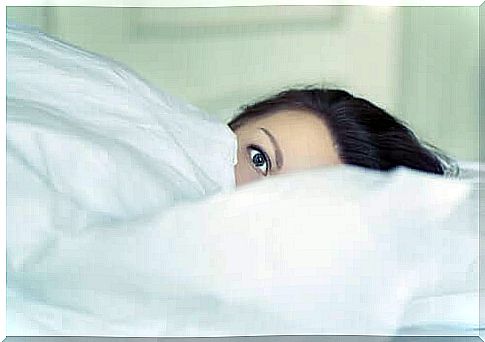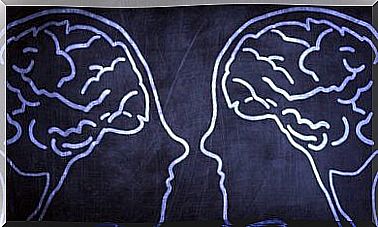Hypersomnia: The Uncontrollable Desire For Sleep

In this article we are talking about hypersomnia: the uncontrollable desire for sleep. Sleep disorders are a huge problem all over the world. Insomnia is the most common disorder. In fact, it is believed that about a third of the world’s population today struggles with insomnia.
Hypersomnia, the uncontrollable desire for sleep, is just one of many possible causes of insomnia, although it can also be a symptom of insomnia itself. Today we are going to look at the various causes of this vicious circle.
According to the American Academy of Sleep Medicine (AASM), between 33 and 50% of the adult population in the United States has difficulty falling asleep or staying asleep. This statistic is very significant. Ironically, an obsession with sleep can cause sleep disturbances such as excessive daytime sleepiness or hypersomnia.
In this article, we learn more about the symptoms, causes, and treatment of hypersomnia. We are also investigating the possible relationship between this condition and other psychological and physical problems.

What Is Hypersomnia And How Is It Different From Other Sleep Disorders?
The term hypersomnia refers to the intense desire for sleep, to the point where it becomes an obsession. This obsession can take place no matter how many hours of sleep a person gets at night.
However, it often has to do with problems such as insomnia. It is important to distinguish between hypersomnia and other similar terms, such as clinomania and narcolepsy.
For example, clinomania refers to the desire or obsession to stay in bed for as long as possible. Not to be confused with the classic ‘5 more minutes’ routine, which we all do when our alarm clocks go off in the morning.
Clinomania means that the person in question has no intention of getting up and refrains from all other activities in order to stay in bed. This is not necessarily about staying in bed to sleep.
Narcolepsy is an organic condition in which a person has an extreme tendency to fall asleep. This is accompanied by periods of cataplexy. This is when the person experiences sudden muscle weakness, hypocretin deficiency (also known as orexin), and shortened REM sleep latency (less than or equal to 15 minutes).
Causes and Effects of the Craving for Sleep
Hypersomnia can be both the cause and the result of a number of sleep disorders. In some cases, it even masks other underlying issues. In many cases, insomnia is the cause of hypersomnia. The decrease in the quality and quantity of our sleep can lead to an obsession with closing your eyes.
But what’s the problem? The problem is that this all-consuming obsession with sleep can actually lead to increasingly severe bouts of insomnia. This creates a vicious circle, where one condition worsens the other.
Constantly thinking about the fact that you need to sleep (because you think you haven’t slept enough) can make you sleepy, even if you’re actually not that tired at all. This sleepiness can mean that you can’t stay alert all day, affecting your work or school performance.
Those who struggle with hypersomnia may also face another problem: trying to sleep when they are not really tired. This can lead them to spend hours in bed thinking they are tired but find they can’t fall asleep. This can make them believe or feel that they are suffering from insomnia.
Depression and Craving for Sleep
On the other hand, sometimes hypersomnia can mask a larger underlying problem. For example, people with depression may spend all day thinking about going to bed. For them, this is the moment when the day finally comes to an end. The moment when they can stop thinking, worrying and suffering.
Melancholic depression is often accompanied by difficulty falling asleep and waking up early in the morning. However, in cases of atypical depression, the predominant sleep problem is often hypersomnia.
If a doctor suspects that someone is suffering from hypersomnia, they should also confirm whether the patient meets the other diagnostic criteria for major depressive disorder. That way, they can make an informed diagnosis and choose the most effective treatment plan.
Possible treatment options for sleep deprivation and insomnia
To choose the best treatment option, a doctor must first perform an evaluation to determine if the hypersomnia is the result of a larger underlying problem. Also, the doctor will have to perform a functional analysis to determine the possible causes and consequences of the problem.
If, after the evaluation, the doctor concludes that the problem is caused by insomnia, the doctor may offer a number of different treatment options to help manage it.
Because it may be the cause of the hypersomnia, tackling the insomnia is essential. If the patient manages to improve the quality or quantity of his or her sleep, the person may find it easier to deal with his or her obsession. Some techniques are:
- Progressive muscle relaxation techniques or autogenous exercises to help the body relax.
- Stimulus Control Techniques: Different ways to avoid behavior that is incompatible with a good night’s sleep and to help establish a regular daily routine.
- Sleep hygiene guidelines: Good habits that make it easier to fall asleep.
- Sleep restrictions to limit the number of hours you spend awake in bed.
- Paradoxical intent: A commonly used technique to prevent patients from worrying about their insomnia.
Paradoxical intention
The latter technique can be very useful in cases where hypersomnia is both the cause and the result of insomnia. In these cases, the fact that the person often sleeps poorly leads to them becoming obsessed with the idea that they need more sleep.
This obsession, in turn, becomes what keeps them from sleeping well. Paradoxical intent can be used to break that vicious circle.
This technique consists of asking the person to spend as much time awake in bed as possible. By changing the command from “you must sleep” to “you must stay awake,” the obsession with sleep suddenly disappears. This shift in focus often means that the person in question finds it much easier to fall asleep.

Our brain plays games with us
The link between hypersomnia and insomnia is a clear example of how our own brains can sabotage us. Everyone worries from time to time.
In many cases it can help us to find a solution to our problems. However, worrying too much can also make things worse. It’s almost as if our brains have an “acceptable care threshold.” If we exceed that, we lose the ability to solve problems, even when the solution is within reach.
Some people spend so much of their time worrying about how much sleep they got last night, making it a chronic condition.
While this doesn’t mean you shouldn’t pay close attention to your sleeping habits, it’s important to worry in a helpful and constructive way, without worrying about robbing you of a good night’s sleep.









